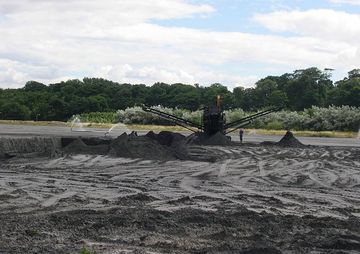Coal ash

Coal ash, sometimes called coal combustion residuals, is produced from the burning of coal in coal-fired power plants. This ash contains a number of byproducts that are produced from the burning of coal including:[2]
- Fly Ash: A fine, powdery silica material created when fine coal (pulverized coal) is burned.
- Bottom Ash: A more course ash particle that forms at the bottom of a coal furnace as it is too large to be pulled out through smoke stacks.
- Boiler Slag: Molten bottom ash that turns into pellets when cooled with water.
- Flue Gas Desulfurization Material: A material leftover from the removal of sulfur dioxide that can be a wet sludge or a powdered material mixed with assorted sulfates.
Coal ash is one of the largest forms of waste generated in the United States and in many countries around the world—with more than 100 million tonnes of coal ash produced in 2012 in America alone.[2] The fact that there is so much coal ash is an issue, and the content of the coal ash is also concerning. Coal ash contains lead, arsenic, mercury, cadmium, and uranium.[5] Thus it is very harmful for coal ash to be released into the environment. Spills of coal ash can pollute waterways, ground water, drinking water, and the air. To address the risks involved in disposing coal ash, there have been rules set up for coal ash disposal.[2]
Disposal and Recycling
Since the environmental impact of coal ash is significant, there is dispute about what method is best to deal with the waste. Some power plants dispose of coal ash in surface impoundments or in landfills, while others get rid of the ash by putting it into a waterway. A small amount of dry coal ash is sometimes put back into the abandoned mine.[6] It can also be recycled into several different materials. Fly ash has long been used as an additive in cement, grout, or concrete. In addition, it's used to stabilize road beds as a fill material.[5] Bottom ash is also used to stabilize as a fill or control the snow on roads. About 43% of the fly ash in the USA is recycled.[5] Re-purposing this coal ash reduces greenhouse gas emissions by decreasing the space they would otherwise take up in landfills. Greenhouse gas emissions are reduced because concrete and brick making are significant contributors to greenhouse gas emissions, and thus using fly ash to reduce the amount of brick or concrete produced helps reduce these emissions. There are also economic benefits of re-purposing coal ash. This includes reduced costs associated with its disposal, increased revenue from the sale of new coal ash products, and savings from using coal ash instead of other more costly materials. Although re-purposing this ash reduces environmental effects, there are critics who say that the use of fly ash in building materials is dangerous, as there could be air contamination from leaching chemicals.[5]
For Further Reading
- Fly ash
- Bottom ash
- Boiler slag
- Coal combustion residuals
- Coal fired power plant
- Or explore a random page
References
- ↑ Richard Webb. (July 13, 2015). Ash Lagoon [Online]. Available: http://www.geograph.org.uk/photo/33736
- ↑ 2.0 2.1 2.2 EPA. (July 10, 2015). Coal Ash Basics [Online]. Available: http://www2.epa.gov/coalash/coal-ash-basics
- ↑ 3.0 3.1 Photo taken by a member of the Energy Education team.
- ↑ American Coal Ash Association. (September 19, 2015). Boiler Slag [Online]. Available: https://www.acaa-usa.org/About-Coal-Ash/What-are-CCPs/Boiler-Slag
- ↑ 5.0 5.1 5.2 5.3 Ed Dodge. (July 13, 2015). Can Coal Fly Ash Waste Be Put to Good Use? [Online]. Available: http://breakingenergy.com/2014/02/18/can-coal-fly-ash-waste-be-put-to-good-use/
- ↑ Clean Water Action. (July 21, 2015). Managing Coal Ash [Online]. Available: http://cleanwateraction.org/page/managing-coal-ash


![Figure 2. Fly ash.[3]](/wiki/images/thumb/b/b1/Flyash.jpg/300px-Flyash.jpg)
![Figure 3. Bottom ash.[3]](/wiki/images/thumb/c/c4/Bottomashfinal.jpg/300px-Bottomashfinal.jpg)
![Figure 4. Boiler slag.[4]](/wiki/images/thumb/e/e4/Boilerslag-scoop600.jpg/383px-Boilerslag-scoop600.jpg)